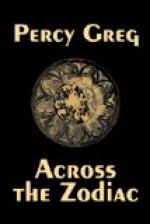crescent in question. I watched long and with
intense interest the gradual change, but I was called
away from it by a consideration of no little practical
moment. I must now be moving at a rate of nearly,
if not quite, 40,000 miles an hour, or about a million
miles per diem. It was not my intention, for
reasons I shall presently explain, ever greatly to
exceed this rate; and if I meant to limit myself to
a fixed rate of speed, it was time to diminish the
force of the apergic current, as otherwise before its
reduction could take effect I should have attained
an impulse greater than I desired, and which could
not be conveniently or easily diminished when once
reached. Quitting, therefore, though reluctantly,
my observation of the phenomena below me, I turned
to the apergion, and was occupied for some two or
three hours in gradually reducing the force as measured
by the cratometer attached to the downward conductor,
and measuring with extreme care the very minute effect
produced upon the barycrite and the discometer.
Even the difference between 200 and 201 radii of elevation
or apogaic distance was not easily perceptible on
either. It took, of course, much more minute
observation and a much longer time to test the effect
produced by the regulation of the movement, since
whether I traveller forty, forty-five, or forty-two
thousand miles in the course of one hour made scarcely
any difference in the diameter of the Earth’s
disc, still less, for reasons above given, in the
gravity. By midnight, however, I was satisfied
that I had not attained quite 1,000,000 miles, or 275
terrestrial radii; also that my speed was not greater
than 45,000 miles (11-1\4 radii) per hour, and was
not, I thought, increasing. Of this last point,
however, I could better satisfy myself at the end of
my four hours’ rest, to which I now betook myself.
I woke about 4h. 30m., and on a scrutiny of the instruments,
felt satisfied that I was not far out in my calculations.
A later hour, however, would afford a more absolute
certainty. I was about to turn again to the interesting
work of observation through the lens in the floor,
when my attention was diverted by the sight of something
like a whitish cloud visible through the upper window
on my left hand. Examined by the telescope, its
widest diameter might be at most ten degrees.
It was faintly luminous, presenting an appearance very
closely resembling that of a star cluster or nebula
just beyond the power of resolution. As in many
nebulae, there was a visible concentration in one
part; but this did not occupy the centre, but a position
more resembling that of the nucleus of a small tailless
comet. The cloudlet might be a distant comet,
it might be a less distant body of meteors clustering
densely in some particular part of their orbit; and,
unfortunately, I was not likely to solve the problem.
Gradually the nebula changed its position, but not
its form, seeming to move downwards and towards the
stern of my vessel, as if I were passing it without




